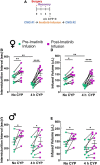Imatinib Mesylate Reduces Voiding Frequency in Female Mice With Acute Cyclophosphamide-Induced Cystitis
- PMID: 35645740
- PMCID: PMC9135974
- DOI: 10.3389/fnsys.2022.867875
Imatinib Mesylate Reduces Voiding Frequency in Female Mice With Acute Cyclophosphamide-Induced Cystitis
Abstract
Lamina propria interstitial cells that express the tyrosine kinase receptor, platelet-derived growth factor receptor alpha (PDGFRα) may play a role in urinary sensory signaling. Imatinib mesylate, also referred to as imatinib, is a tyrosine kinase inhibitor that can inhibit PDGFRα and has been widely used in urological research. We evaluated the functional effects of imatinib administration (via oral gavage or intravesical infusion) with two different experimental designs (prevention and treatment), in a cyclophosphamide (CYP)-induced cystitis (acute, intermediate, and chronic), male and female rodent model using conscious cystometry and somatic sensitivity testing. Imatinib significantly (0.0001 ≤ p ≤ 0.05) decreased voiding frequency and increased bladder capacity in acute CYP-induced cystitis, by the prevention (females) and treatment (females and males) designs. Imatinib was not effective in preventing or treating intermediate or chronic CYP-induced cystitis in either sex. Interestingly, in the prevention experiments, imatinib administration increased (0.0001 ≤ p ≤ 0.01) voiding frequency and decreased bladder capacity in control mice. However, in the treatment experiments, imatinib administration decreased (0.01 ≤ p ≤ 0.05) voiding frequency and increased bladder capacity in control mice. Bladder function improvements observed with imatinib treatment in acute CYP-induced cystitis mice remained and additionally improved with a second dose of imatinib 24 hours after CYP treatment. Imatinib administration did not affect pelvic somatic sensitivity in female mice with acute CYP-induced cystitis. Our studies suggest that (1) imatinib improves bladder function in mice with acute CYP-induced cystitis with a prevention and treatment design and (2) interstitial cells may be a useful target to improve bladder function in cystitis.
Keywords: conscious cystometry; imatinib mesylate; interstitial cells; interstitial cystitis; platelet-derived growth factor receptor (PDGFR); somatic sensitivity.
Copyright © 2022 Perkins, Girard, Campbell and Vizzard.
Conflict of interest statement
The authors declare that the research was conducted in the absence of any commercial or financial relationships that could be construed as a potential conflict of interest.
Figures







References
Grants and funding
LinkOut - more resources
Full Text Sources
Miscellaneous

